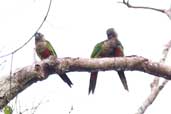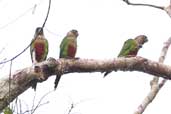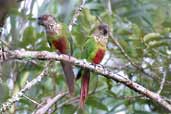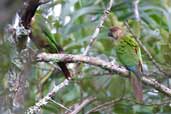(aka Santarem Parakeet Pyrrhura amazonum snethlageae)

April 2003
Recently Leo Joseph has done some work on the Pyrrhura picta complex and has concluded that Madeira Parakeet is a full species.

Joseph, L. 2002. Geographical variation, taxonomy and distribution of some Amazonian Pyrrhura parakeets. Ornitologia Neotropical 13: 337-363.
The first two photos were taken from the edge of a forest remnant close to the town of Ariquemes. Although the photos are a bit distant, we did have excellent views through the scope which showed the distinctive chest markings very well.

April 2003
The 3rd and 4th photos were taken on the Serra trail at the Cristalino Lodge in Mato Grosso. I had initially assumed that they were Hellmayr's Parakeet P. amazonum and am grateful to Leo Joseph for pointing out this misidentification on my part.

"I just came across your pictures on the web of Hellmayr's and Madeira Parakeets and thought I'd drop you a line. First of all, thank you for the reference to my article but the other reason for writing is that they ALL look like beautiful shots of Madeira Parakeets. The ones labelled as Hellmayr's [these were photos 3 and 4] show the trademark narrow black vertical marks on a very pale background giving that pointed appearance of the feathers on the chest of P. snethlageae (= Madeira Parakeet) and I am guessing that the locality of being outside the drainage of the Madeira is what has caused the problem. The precise eastern limits of snethlageae and western limits of amazonum were unclear in my study so the photos are an important contribution to showing that snethlageae is outside the Madeira drainage.
The variation in orbital ring colour is interesting and was not something I could get from skins so it looks as though there is a lot more to learn!"
Some discussion of this complex group is to be found on the South American Classification Committee page.
| Previous Page | Back to Index | Next Page |